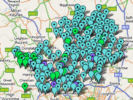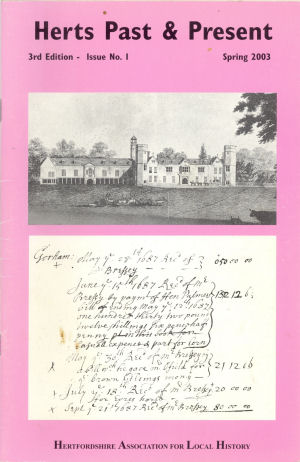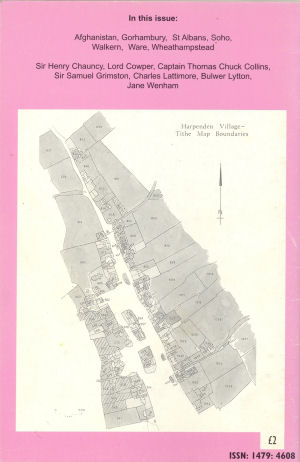|
|
Herts Past and Present Hertfordshire Association for Local History Spring 2003 - No 1 |
|
|
In This Issue Afghanistan, Gorhambury, St Albans. Soho, Walkern, Ware, Wheathampstead Sir Henry Chauncy, Lord Cowper, Captain Thomas Chuck Collins, Sir Samuel Grimston, Charles Lattimore, Bulwet Lytton, Jane Wenham
|
Brief Guide to Sources - Tithe Maps and Apportionments - by David Short |
|
|
Jane Wenham of Walkern - The last woman in England to be tried for witchcraft, 1712 - by Anne How |
||
|
A surprising feature of the last trial of a witch in England was not that it took place in Hertfordshire and at the start of what we think of as the enlightened eighteenth century, but that it was well-educated members of the ruling class who brought the prosecution. Sir Henry Chauncy, local squire and well-known antiquarian, with the support of several local clergymen was instrumental in bringing charges against Jane Wenham. This account reveals tensions between the local authorities, who equated belief in witches and the efficacy of prayers for exorcism with true religion and virtue, and the more enlightened sceptical judges of the day, accounted by their opponents to be of dangerously liberal and Whiggish tendency. It was not only the ignorant poor who believed in witchcraft at the beginning of the eighteenth century. Walkern in the early 18th century Poor relief and charity in eighteenth-century Walkern Widow and deserted wife A daughter? The maid-servant bewitched ... evidence from the trial The devines and proofing of witchcraft Sir Henry Chauncy's involvement Bragge's account of an exorcism The judge, Justice Powell: sentence and pardon in the same year A neighbour's testimony and the judge's scepticism Vindicated at last |
||
|
Agriculture and Politics in Mid-Nineteenth Century Hertfordshire - The Farmers' Protection Movement, Free Trade and the Corn Laws - by Nigel Agar |
||
|
Mid-nineteenth-century Hertfordshire newspapers reveal some unexpected features of the fight of local farmers in the 1840s to protect their corn growing interests. It was the farmers themselves who organised and led the protectionism movement, not, as one might expect, landlords and gentry - a sign, perhaps, of the growing power and independence of a newly enfranchised group. The cause of Protectionism split the Tory party and brought down the government of the day. Initially at odds with the rest of the country on the question of free trade, most Hertfordshire farmers found themselves forced by Peel's Repeal of the Corn Laws to face up to competition. They found that what they had feared in fact led to considerable improvements both in farming methods and the living conditions of labourers. Nigel Agar has focused on an exciting period of change when powerful interests competed for votes and new players appeared on the political scene. As ever, in Hertfordshire's history the proximity of London provided a catalyst for change. Hertfordshire's responses to the threatened repeal of the Corn Laws A farmer's movement Dissenting voices: Charles Lattimore, the farming free trader from Wheathamstead The Repeal of the Corn Laws and a change of government Protectionism and local politics Tension between farmers and landowners Increased efficiency following the Repeal of the Corn Laws The golden age of mid-century agriculture The growing power of urban over rural interests |
||
|
A Gentleman's life in Soho and St Albans, 1660-1689 - The Gorhambury Account Books for Sir Harbottle Grimston and Sir Harbottle Grimston - by Frank Kilvington |
||
|
Old account books offer unexpected pleasures, as Frank Kilvington discovers in this reading of the Gorhambury account books for 1660-1689. In his capacity as Master of the Rolls, Sir Harbottle Grimston maintained a London house in Soho as well as his country estate in St Albans. We catch tantalizing glimpses of domestic life as managed in the town and country households of the Grimston family in the late seventeenth century Here is daily life in all its detail from the gold hat-band for a page boy to the cost of a new chain for Hercules (the dog or horse?). Various St Albans trades people make an appearance, and travel arrangements for the journey between London and St Albans seem to have been as costly and complicated then as now. Book 1, 1660- Book 2, October 1684 - January 1688 Book 3, September 1686-June 1689 Travel and transport arrangements between London and St Albans Household servants and St Albans tradesmen London high life The cost of food: suppliers, deliveries and post Country life Work on the country estate Charity and welfare payments Plague, water and oranges |
||
|
From Ware to Afghanistan - Captain Thomas Chuck Collins and the retreat from Kabul, 1842 - by Aline Burgess |
||
|
Starting with the words on a memorial in Ware parish church, Aline Burgess went on to research the campaign history of her great-grandfather's brother who soldiered in India and Afghanistan during the mid-Victorian period. She was rewarded with the discovery that her ancestor had played a significant part in the First Afghan War. The flight from Kabul in the depths of winter, with pregnant women and children, under constant attack from tribesmen is a gripping piece of military and imperial history. The journey ended in the loss of an entire British army. Fortunately the sole survivor returned to Ware to visit the family of his fallen comrade-in-arms and told them the tale. This is family history at its most compelling. Ten years in Bengal, 1827-37 Trouble in Kabul The decision to leave for Jalalabad The winter retreat A dreadful journey under constant attack One of the last few The last stand at Gandamark A visit from a sole survivor |
||
|
Also editorial, news items, dates for the diary, and book reviews |



